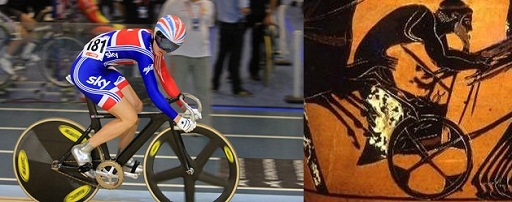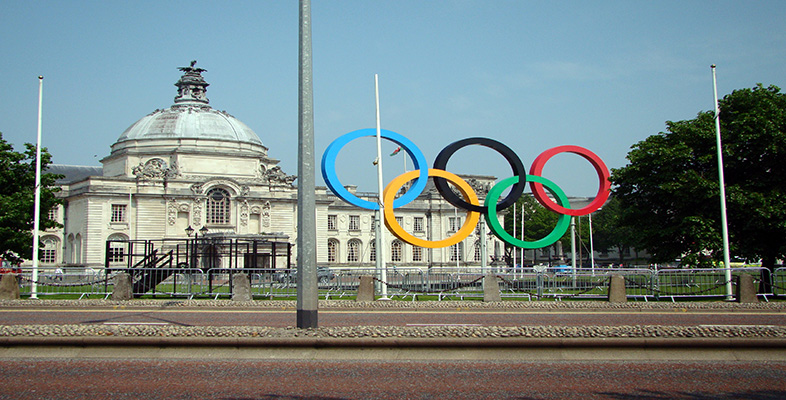6.1 Equestrian Events
The equestrian events opened the sporting competitions in the Ancient Olympics. Compared to the simplicity of the athletic events, the equestrian races were flamboyant and ostentatious. Impressive racing horses and expensive chariots were paraded in front of spectators, and some prominent citizens used the event as an opportunity to flaunt their wealth and status. Chariot entries were sometimes sponsored by states rather than individuals, which was unheard of for other Ancient Olympic disciplines, and some competitors entered more than one chariot in an attempt to increase their chances of winning. For example, according to Thucydides (VI.18.16 [Tip: hold Ctrl and click a link to open it in a new tab. (Hide tip)] ), the extravagant Alcibiades entered as many as seven chariots into the same race, winning first, second and fourth prize simultaneously.
Equestrian events were also unusual in that they were the only discipline that allowed adult women to compete. This was due to the fact that the owners of the chariots and horses were regarded as the real competitors in the event, rather than the riders or charioteers (who were frequently anonymous slaves or hired professionals). Therefore, as long as a female contestant entered the competition as an owner, this was considered to be within the rules. Before the start of the races, the Hellanodikai classified the horses into age groups in order to ensure fairness and equality (but there were no group divisions for jockeys or chariot drivers).
Equestrian events took place in the hippodrome, a large oval arena constructed to the east of the Altis and to the south of the stadion Although the location of the hippodrome was identified in 2008 thanks to geophysical survey techniques, no archaeological remains have been uncovered yet, so most of what we know about it is based on interpretations of ancient texts. It is believed that two large pillars stood at either end of the racing track to mark the turns (which were the most dangerous parts of the course). Races started in a dramatic staggered sequence, using a mechanism called the hippaphesis. This involved arranging the contestants in a prow formation and allowing the two individuals at the very back to start first, followed by the ones immediately in front of them, and so on until all competitors formed a straight line. At that precise point, a trumpet was blown and the race officially began.
Animation 2 tethrippon race
The first equestrian race to be held on the second day of the Olympics was the four-horse chariot (the tethrippon), which was the fastest and most dangerous of all. This was followed by the horseback races (the kele), which were roughly similar to modern horse races except that jockeys rode without stirrups. Next came the two-chariot race. During the 5th century BCE, two other equestrian events were held at the hippodrome – the apene (a mule-cart race) and the kalpe (a competition in which, apparently, jockeys had to complete the last lap by foot); however, these events were probably not very popular, as they disappeared relatively quickly. Towards the end of the 4th century BCE, a four-foal chariot race was added. The length of the races was 12 laps around the track (i.e. approximately nine miles) for the chariots and six laps (i.e. approximately four and a half miles) for horseback races.
So what’s the difference?: wheel designs: modern bicycles and Ancient Greek tethrippa

What do you think are the main differences between modern bicycle wheels and the wheels of the Ancient Greek tethrippa? What are the factors affecting these differences? Once you have come up with a few ideas, click on ‘reveal comment’ to read some of our suggestions.
Comment
It would seem that the differences are obvious; sleek, modern and highly engineered against rough, ancient and hand crafted, but there are similarities when we look more closely. The aim is the same – to win a race using wheels and muscle power. And there lies the key technical similarity: how to get the most effective wheels? They need to be strong to survive all the loads applied to them; they need to be stiff; they need to be light. The heavier a wheel the more effort is needed to rotate it. But lightness brings the risk of reduced strength and stiffness.
The more common modern multi-spoke bicycle wheel is one of the most efficient structures ever created – its strength to weight ratio is excellent and its spokes are always kept stretched – but the large number of narrow spokes leads to air resistance as the wind circulates around each spoke and becomes turbulent (i.e. with a complex and erratic movement). This limitation moves the solution to a wheel design with four or five broad spokes. Since this is better manufactured in one piece, it requires a spoke that can take tensile and compressive (i.e. stretching and squeezing) loads.
Something the modern day Olympians share with their ancient counterparts is the solution to this spoke problem. Granted they used the natural material of wood and we use carbon fibre reinforced polymer (i.e. basically a plastic strengthened by strands of carbon), but both are examples of composite materials in that they have dissimilar materials working together. Wood has cellulose tubes with lining bonds whereas modern wheels have carbon fibres in an epoxy or polyester matrix (i.e. bonding plastic). Each provides a stiff, strong spoke which can compress without buckling but still be easy to rotate. So the wheels of the tethrippon might seem a long way from the bicycle wheels of today’s Olympics but they share a common approach – they minimise the weight, streamline the profile and maintain the strength and stiffness.
